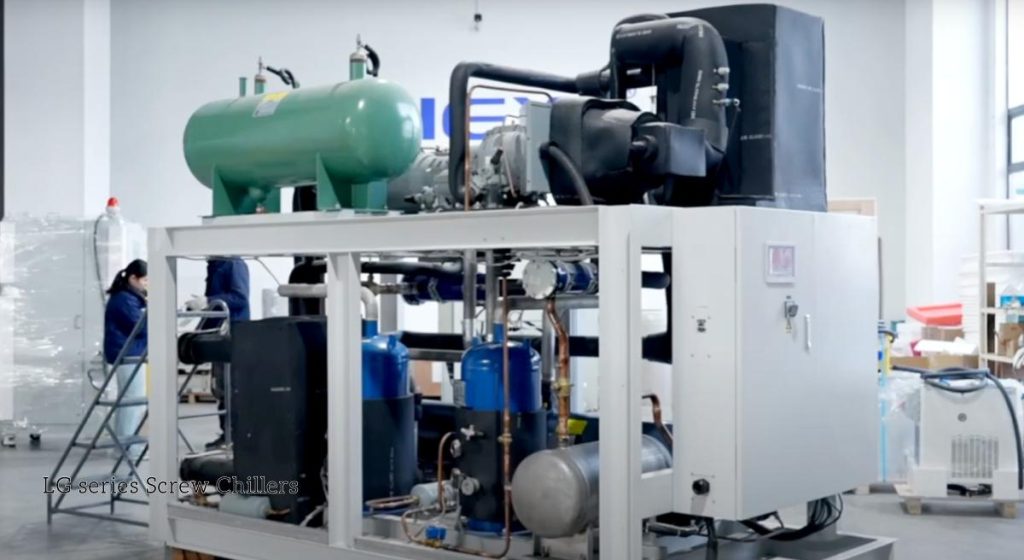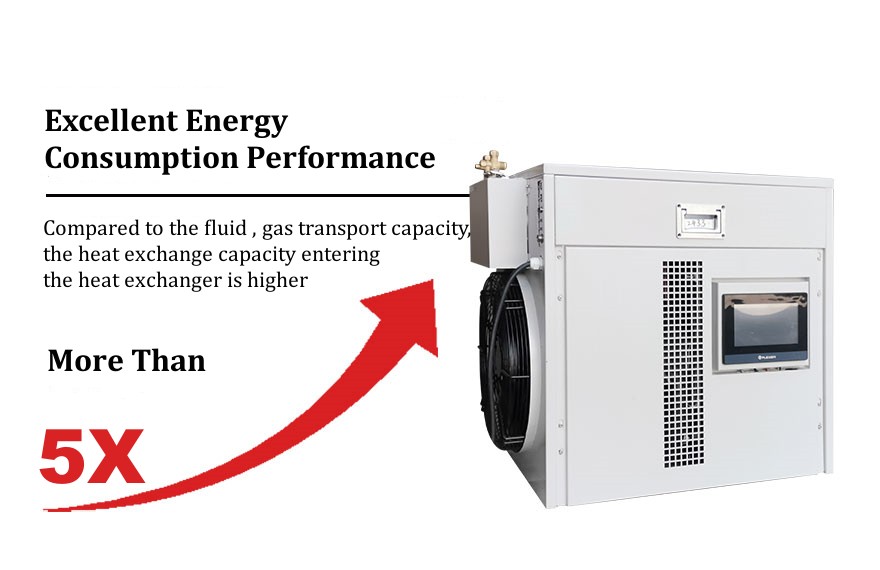Wie man ein Typenschild eines Chillers liest
Wenn erfahrenes Wartungspersonal für Chiller einen Maschinenraum betritt, überprüfen sie normalerweise nicht zuerst die Rohrleitungen oder die Anzeigen. Es ist das Typenschild des Chillers. Diese kleine Platte sagt ihnen fast alles, was sie wissen müssen, bevor sie überhaupt das Bedienfeld öffnen.
Lustigerweise ignorieren viele Bediener und sogar einige Wartungstechniker sie. Sie rennen Alarmen hinterher oder raten über die Kältemittelmenge, obwohl die Informationen die ganze Zeit buchstäblich an der Maschine befestigt waren.
Das Lesen des Typenschilds ist der erste Schritt. Egal, ob Sie eine neue Einheit installieren, eine alte Fehlersuche durchführen oder einfach herausfinden wollen, ob das System eine neue Prozesslast bewältigen kann, diese Platte ist Ihr erster Bezugspunkt. Schauen wir uns an, was darauf steht und warum es wichtig ist.
Hersteller & Zertifizierungszeichen
First up, the name. But it’s more than branding. If technicians see the builder, they already know what kind of controls or refrigerant to expect. Right next to the logo you’ll often see marks like UL, CE, or CSA. Those logos tell you the unit passed certain tests.
Modellnummer & Seriennummer
Die Modellnummer gibt Ihnen den Stammbaum der Maschine. Normalerweise kann man allein daraus Größe, Serie und manchmal sogar die Konfiguration erkennen. Die Seriennummer ist persönlicher. Betrachten Sie sie als Geburtsurkunde.
Wenn Sie die Chiller-Fabrik wegen eines Geräteausfalls anrufen, lautet die erste Frage: „Wie lautet die Seriennummer?“ Wenn Sie diese nicht haben, sitzen Sie praktisch fest. Ersatzteile, Schaltpläne, Kompressortyp — alles hängt von dieser Nummer ab.
Kühlleistung
Dies ist die Zeile, auf die die meisten Betriebsleiter achten. Die Kühlleistung wird in Tonnen, kW oder BTU/h angegeben. Aber hier ist der Haken: es ist nicht immer die Zahl, die Sie in der Praxis sehen werden. Der Wert auf dem Typenschild basiert auf Standard-Testbedingungen. Ändern Sie die Eintrittswassertemperatur oder die Umgebung, und die Kapazität verschiebt sich.
Ein Team installierte einmal einen Chiller mit 100 Tonnen Nennleistung, in der Annahme, dass er ihren Prozess abdecken würde. Auf dem Papier sah es gut aus. In Wirklichkeit, bei wärmerem Prozesswasser, lieferte er nur 80. Dieses Defizit beeinträchtigte die Produktion, bis sie eine temporäre Einheit mieteten.
Spannung, Phase und Frequenz
Dieser Teil sieht einfach aus, bringt aber viele Leute in Schwierigkeiten. Das Typenschild zeigt genau, welche Spannung und Phase der Chiller erwartet. Es listet auch die Frequenz, 50 oder 60 Hz.
Ein brandneues Gerät wurde einmal an die falsche Versorgung angeschlossen, weil niemand doppelt überprüft hatte. Die Motoren überhitzten, Schutzschalter lösten aus. Tatsächlich hätten nur zehn Minuten am Typenschild drei Tage Ausfallzeit gespart.
Kältemitteltyp
Der Kältemitteltyp gibt an, was sich im Gerät befindet und was für die Wartung benötigt wird. R134a, R410A oder manchmal eine der neueren Low-GWP-Mischungen. Das Mischen von Kältemitteln oder die Verwendung des falschen Typs kann zum Ausfall des Kompressors führen.
Es ist auch für Vorschriften relevant. Wenn Sie ein älteres Kältemittel auf dem Typenschild sehen, wie R22, wissen Sie sofort, dass die Einheit entweder alt oder nachgerüstet ist. Das ändert die Planung von Wartung und Ersatz.
Maximaler Betriebsdruck
This number lists the max safe pressure for the system. High side and low side. These aren’t just numbers—they’re safety limits. If your gauges or hoses aren’t rated for those numbers, you’re in dangerous territory.
Durchfluss & Temperaturbereich
Nicht jedes Typenschild gibt dies an, aber wenn doch, achten Sie darauf. Empfohlene Durchflussmenge und Temperaturbereich zeigen, wie das System ausgelegt ist, um zu arbeiten. Zu wenig Durchfluss und der Verdampfer kann einfrieren. Zu viel und Sie verschwenden Pumpenenergie.

Entdecken Sie hocheffiziente und energiesparende Chiller-Lösungen!
Why Reading the Chiller Nameplate Matters?
Most operators don’t think about the nameplate until there’s a problem. That’s a mistake. It should be the first reference, not the last.
Korrekte Installation
Eine korrekte Installation bedeutet, dass Stromversorgung, Durchfluss und Kühlleistung dem Typenschild entsprechen. Wenn Sie diese Überprüfung überspringen, riskieren Sie lange Verzögerungen, wenn etwas nicht passt.
Fehlerbehebung
Wenn Alarme auftreten, verknüpft die Seriennummer Sie mit Handbüchern und Werksunterlagen. Die Kühlleistung gibt einen Leistungsmaßstab. Der Kältemitteltyp legt die Erwartungen für die Betriebsdrücke fest.
Sicherheitsverbesserung
Druckwerte, Zertifizierungen und elektrische Daten betreffen alle die Sicherheit. Das Lesen verhindert Unfälle.
Wartung & Ersatzteile
Ever tried to order a replacement pump or valve without the model and serial? It’s a nightmare. With those numbers, you get the right parts the first time. Without them, you’re guessing.
Schlussfolgerung
Suchen Sie nach dem richtigen Industrie-Chiller für Ihr neues Projekt? LNEYA hat luft- und wassergekühlte Geräte mit verschiedenen Leistungsstufen vorbereitet.
Möchten Sie die Ausrüstung anpassen, die am besten zu Ihrer einzigartigen Anwendung passt? LNEYA bietet auch kundenspezifische Dienstleistungen an. Wir können Ihre unterschiedlichen Anforderungen erfüllen.
Kontaktieren Sie uns noch heute!

- Temperature Control in Photolithography
- Is a Used Chiller a Good Idea
- Chiller Components and Refrigeration Fundamentals Guides
- Chiller Types and Selection Guides
- How Does a Peltier Cooler Work
- Peltier Chiller vs. Compressor Chiller
- What Is a Peltier Chiller
- OEM vs Aftermarket Chiller Spare Parts
- Dezember 2025
- November 2025
- Oktober 2025
- September 2025
- August 2025
- Juli 2025
- Juni 2025
- Mai 2025
- März 2025
- Februar 2025
- Januar 2025
- Dezember 2024
- November 2024
- Oktober 2024
- September 2024
- August 2024
- Juli 2024
- Juni 2024
- Mai 2024
- April 2024
- März 2024
- Februar 2024
- September 2023
- Juli 2023
- Juni 2023
- Mai 2023
- Januar 2023
luftgekühlte Kältemaschine Kühler Wartung von Kühlanlagen Kältemaschinen Kalte Montage Gefrierschrank Kaltwassersatz dynamisches Temperaturkontrollsystem energieeffizienter Chiller Heizungsumwälzpumpe Industriekühler Industriekälteanlagen Industriekühlung industrieller Gefrierschrank Industriekühlschrank Mantelreaktor Laborkühlschrank Niedertemperaturkühler Nachrichten Prozesskühler process cooling Reaktorkühlung Reaktorheizung Kühlung Kältethermostat Schneckenkühler Halbleiter-Kühlgerät Halbleiter-Testkühler sundi tcu Temperaturkontrolle Prüfkammer Thermostat Ultra-Niedertemperatur-Kühler Fahrzeug-Test-Kühler Kaltwassersatz wassergekühlte Kältemaschine
Verwandte Chiller
KONTAKT US
TEL:
EMAIL:
WeChat & WhatsApp:

Wechat QR

Haben Sie eine Frage oder benötigen Sie ein Angebot? Füllen Sie das untenstehende Formular aus, und unser Team wird sich innerhalb von 24 Stunden bei Ihnen melden.
 LNEYA Industriekühler Hersteller Lieferant
LNEYA Industriekühler Hersteller Lieferant
















